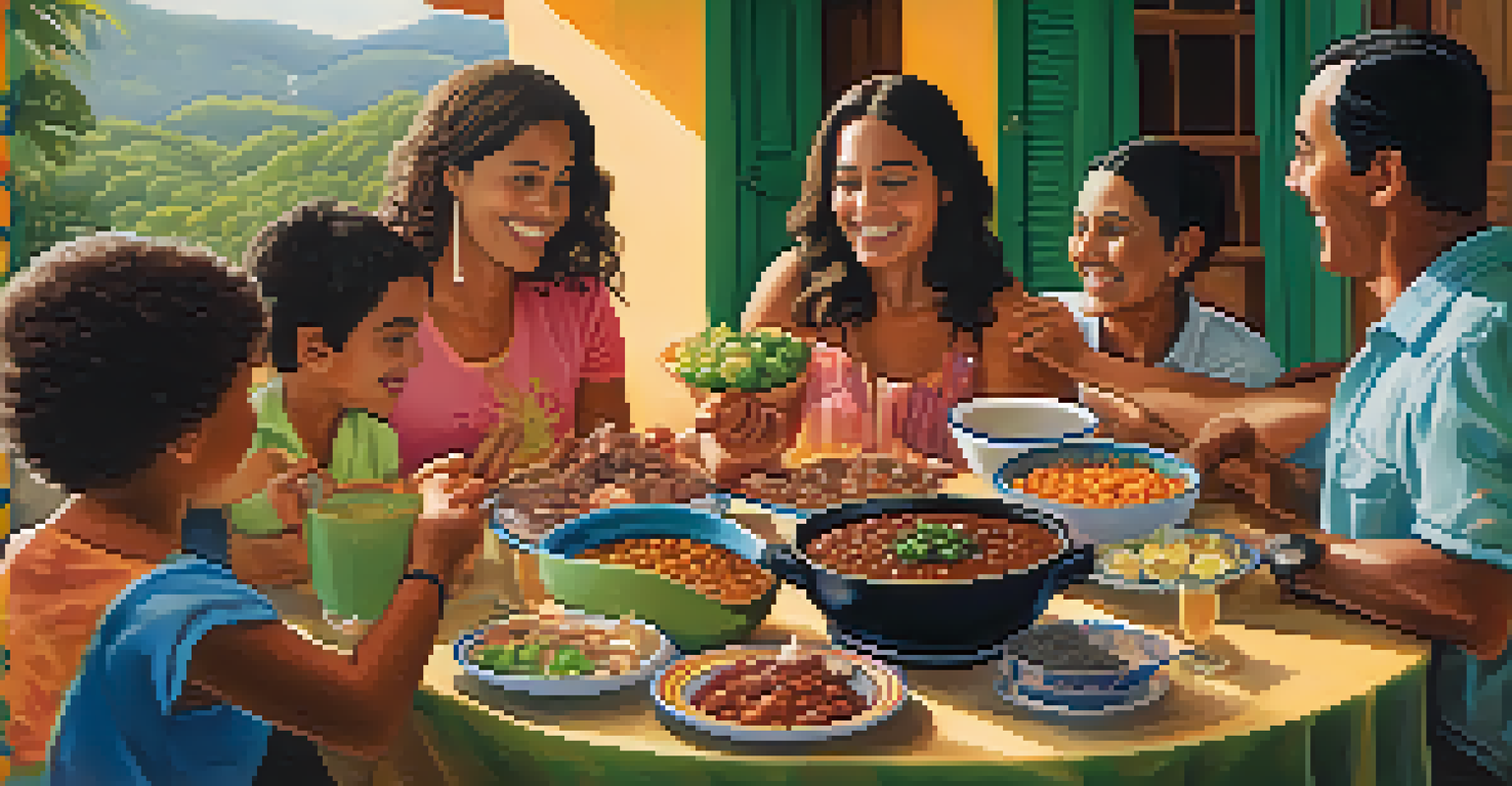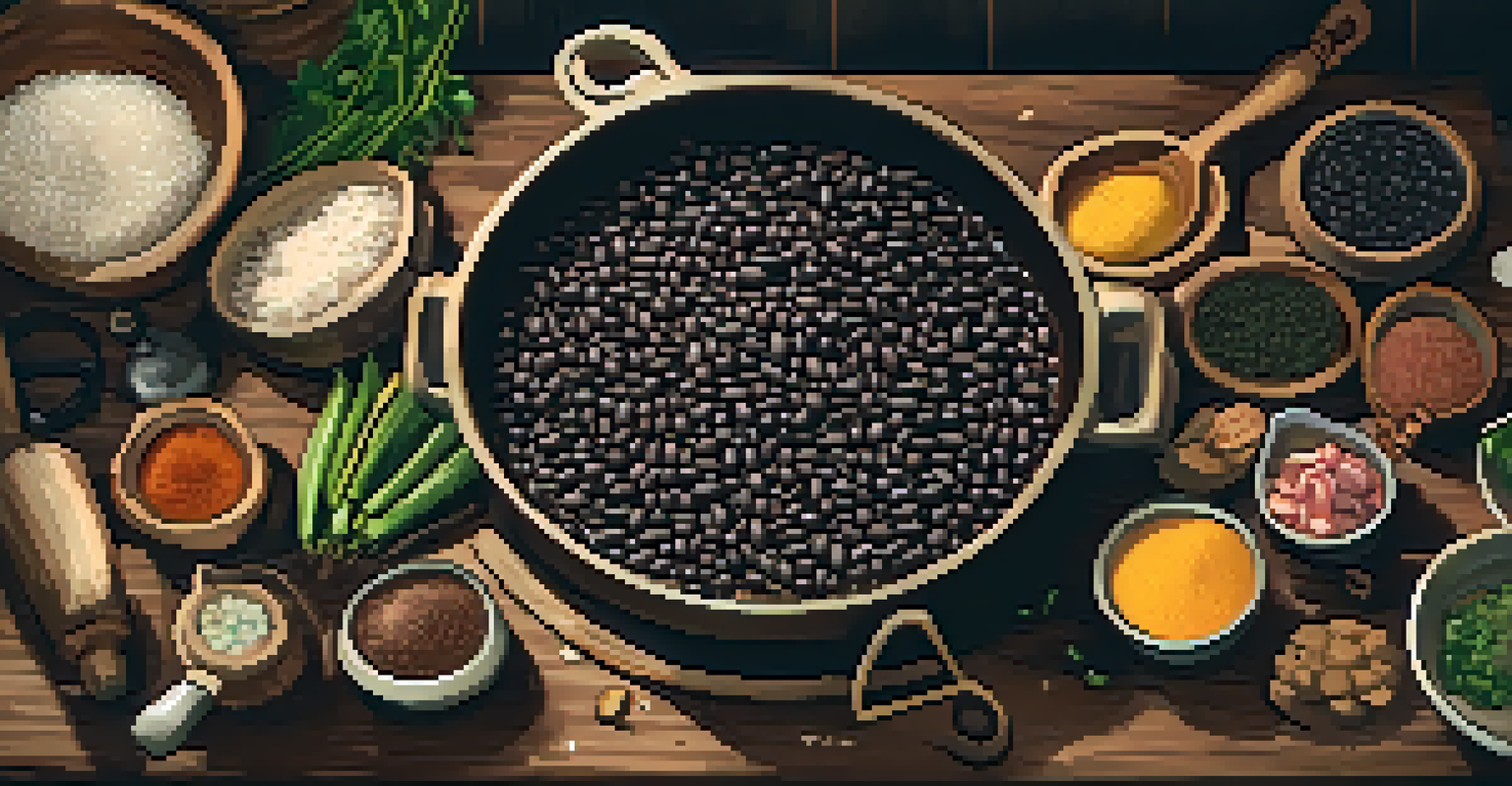Feijoada: Brazil's National Dish and Its Cultural Significance

Understanding Feijoada: A Hearty Brazilian Stew
Feijoada is more than just a dish; it's a cultural emblem of Brazil. Traditionally made with black beans and a variety of meats, such as pork and beef, this stew comes together to create a rich, hearty meal. Each ingredient plays a role, infusing the dish with deep flavors and a warm, comforting essence.
Food is symbolic of love when words are inadequate.
The dish is typically served with rice, collard greens, and orange slices, which add a refreshing contrast to the richness of the feijoada. It's a meal meant for sharing, often enjoyed during family gatherings or festive occasions. The communal aspect of feijoada makes it a centerpiece of Brazilian social life.
Ultimately, feijoada represents the heart of Brazilian cuisine, showcasing the nation's love for flavorful, robust dishes that bring people together. Its preparation is a labor of love, often taking several hours to achieve the perfect blend of flavors.
The Historical Roots of Feijoada in Brazil
Feijoada's origins can be traced back to the 16th century, reflecting Brazil's diverse cultural tapestry. It is believed to have been influenced by Portuguese stew recipes, adapted by enslaved Africans using locally available ingredients. This fusion of cultures is a testament to Brazil's rich history and the way food can tell a story.

The dish was initially created as a way to utilize leftover meats, making it a practical solution for feeding large families. Over time, feijoada evolved into a symbol of Brazilian identity, showcasing the resilience and creativity of its people. It became a beloved dish enjoyed by all, transcending social classes.
Feijoada: A Cultural Icon of Brazil
Feijoada is not just a dish; it embodies Brazil's cultural identity, showcasing flavors that bring families and communities together.
This historical significance is not only found in the ingredients but also in the way feijoada is celebrated. From its humble beginnings to its status as a national dish, feijoada tells a story of cultural adaptation and unity.
How Feijoada is Traditionally Prepared
Preparing feijoada is an art form that requires time and patience. It begins with soaking black beans overnight, allowing them to soften before cooking. The meats, often including pork shoulder, sausage, and beef, are then seasoned and sautéed to deepen their flavors before being combined with the beans in a large pot.
Cooking is like love. It should be entered into with abandon or not at all.
The stew is left to simmer for several hours, allowing the flavors to meld beautifully. It's not uncommon for families to have their own secret ingredients or methods, passed down through generations. This personal touch adds a layer of uniqueness to each feijoada, making every pot a reflection of its maker.
Cooking feijoada is often a communal experience, with family members contributing to the preparation. This brings a sense of togetherness, as everyone eagerly awaits the moment they can sit down and enjoy the fruits of their labor.
Feijoada's Role in Brazilian Celebrations
Feijoada holds a special place in Brazilian culture, often served during festive occasions. Carnival, for instance, is a time when families and friends gather to enjoy this hearty dish, celebrating the spirit of togetherness. It's not just a meal; it's a tradition that brings people closer.
Many restaurants also offer feijoada on Wednesdays and Saturdays, making these days a mini-celebration for locals. This practice highlights the dish's importance in everyday life, transforming a simple meal into a joyous event. The aromas of feijoada wafting through the air evoke feelings of nostalgia and community.
Historical Roots of Feijoada
Originating from a blend of Portuguese and African culinary traditions, feijoada represents Brazil's diverse heritage and adaptability.
The communal spirit of feijoada is a reflection of Brazil's culture, where food is often seen as a way to connect with others. Sharing a pot of feijoada is an invitation to join in, fostering friendships and creating lasting memories.
Feijoada and Its Variations Across Brazil
While feijoada is recognized as Brazil's national dish, regional variations showcase the country's culinary diversity. In Rio de Janeiro, for example, the stew tends to be more meat-heavy, whereas in São Paulo, it might include additional ingredients like smoked meats. Each region adds its own flair, making feijoada a dish that adapts to local tastes.
These variations not only reflect the ingredients available in different areas but also the cultural influences unique to each region. For instance, in the Northeast, you might find feijoada made with different types of beans or spices, highlighting the area's distinct culinary identity. This adaptability keeps the dish relevant and exciting.
Exploring these regional differences in feijoada is like taking a culinary tour of Brazil. Each bowl tells a story of place, culture, and tradition, inviting locals and visitors alike to savor the country's rich flavors.
The Global Impact of Feijoada
Feijoada's influence has extended beyond Brazil's borders, making its mark on international cuisine. As Brazilian culture spreads around the world, so too does the appreciation for this hearty stew. Many restaurants outside Brazil now feature feijoada on their menus, introducing new audiences to its rich flavors.
The global fascination with feijoada often leads to creative adaptations, with chefs experimenting with various ingredients and cooking methods. While these variations may differ from the traditional recipe, they reflect a growing interest in Brazilian cuisine and its distinctive character. It's a beautiful example of how food can bridge cultures.
Regional Variations of Feijoada
Different regions in Brazil put their unique spin on feijoada, reflecting local ingredients and cultural influences, making it a versatile dish.
As feijoada gains popularity worldwide, it serves as a reminder of Brazil's culinary heritage and the power of food to bring people together. Whether enjoyed in a cozy Brazilian eatery or at home, feijoada continues to inspire and connect, transcending geographical boundaries.
Conclusion: Celebrating Feijoada's Legacy
Feijoada is more than just a meal; it's a celebration of Brazil's history, diversity, and community. From its humble beginnings to its status as a cherished national dish, feijoada embodies the spirit of togetherness that characterizes Brazilian culture. Each bowl tells a story, inviting people to share in its legacy.
As we savor this rich, hearty stew, we also honor the traditions and cultures that shaped it. Whether enjoyed at home or in a bustling restaurant, feijoada fosters connection and joy, reminding us of the power of food in our lives. It's a dish that truly brings people together.

So next time you indulge in a bowl of feijoada, take a moment to appreciate not only its delicious flavors but also the rich cultural tapestry it represents. In every bite, you are partaking in a story that spans generations, celebrating the heart and soul of Brazil.